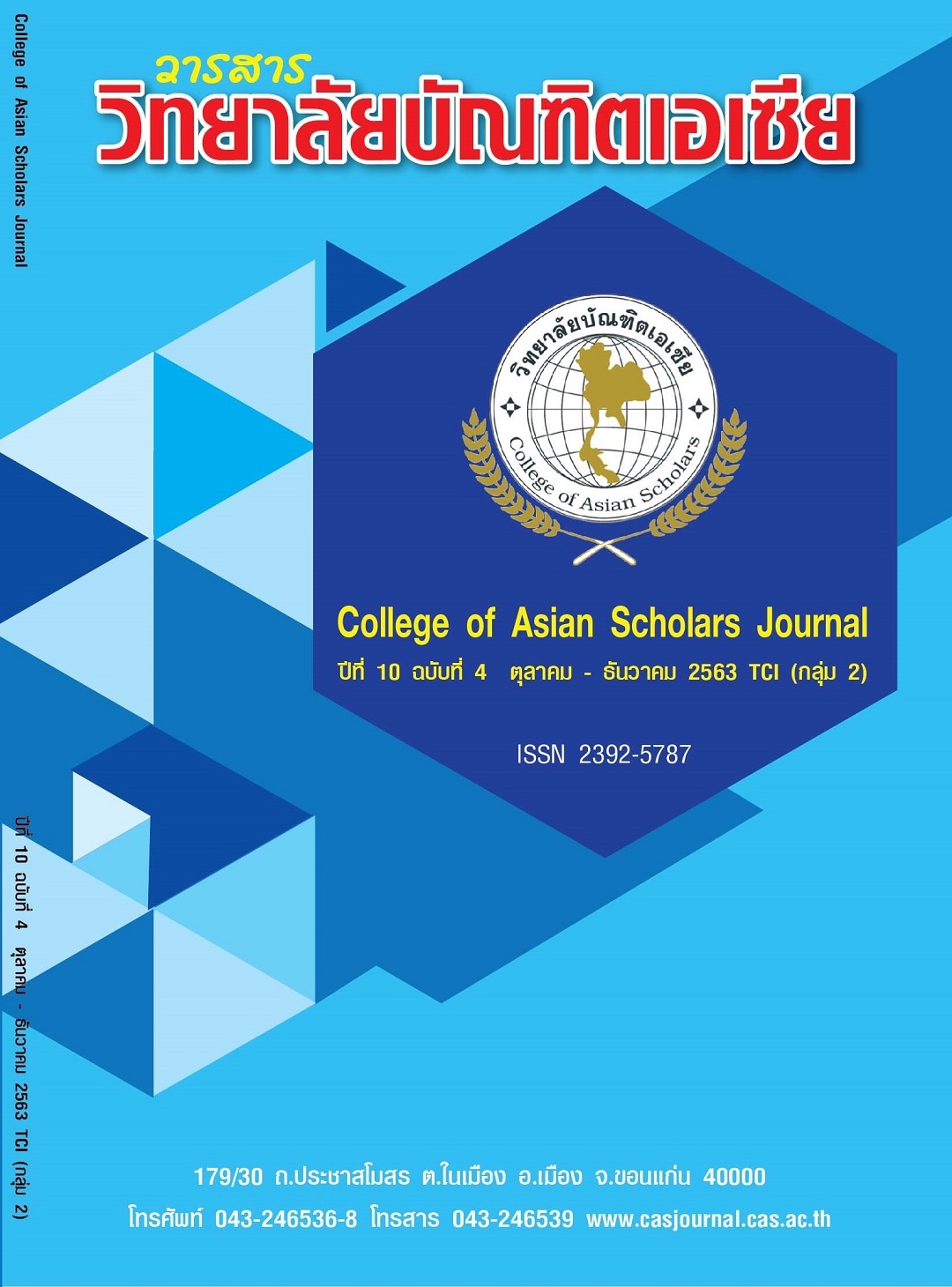ไฟล์ ดาวน์โหลด |
1613382366-10-ED057-T(84-91).pdf |
|||||||||
|
ชื่อผู้วิจัย พัณนิดา ชูสาย
|
|||||||||
| บทคัดย่อ ภาษาไทย |
การศึกษาครั้งนี้มีวัตถุประสงค์เพื่อ 1) ศึกษาเปรียบเทียบผลการทดสอบก่อนและหลังของการยืดกล้ามเนื้อแบบทำให้ต่อองศาการเคลื่อนไหวของข้อไหล่ในนักเรียนที่มีความบกพร่องทางการเคลื่อนไหวที่มีภาวะสมองพิการศูนย์การศึกษาพิเศษ ประจำจังหวัดร้อยเอ็ด 2) ประเมินความพึงพอใจของผู้ปกครองต่อผลการทดสอบก่อนและหลังของการยืดกล้ามเนื้อแบบทำให้ ต่อองศาการเคลื่อนไหวของข้อไหล่ในนักเรียนที่มีความบกพร่องทางการเคลื่อนไหวที่มีภาวะสมองพิการกลุ่มเป้าหมายที่ใช้ในศึกษาครั้งนี้ นักเรียนที่มีความบกพร่องทางการเคลื่อนไหว ของศูนย์การศึกษาพิเศษประจำจังหวัดร้อยเอ็ด 5 คน โดยการเลือกแบบเจาะจง (Purposive Sampling) เครื่องมือที่ใช้ในการศึกษา ประกอบด้วย 1) แผนการจัดการเรียนรู้เกี่ยวกับการยืดกล้ามเนื้อแบบทำให้ตามทฤษฎีของ Proprioceptive Neuromuscular Facilitation (PNF) ของนักเรียนที่มีความบกพร่องทางการเคลื่อนไหวที่มีภาวะสมองพิการ ภาคเรียนที่ 2 ปีการศึกษา 2562 โดยใช้คนละ 6 แผนการเรียนรู้ 2) เครื่องมือที่ใช้ในการวัดองศาการเคลื่อนไหวโกนิโอมิเตอร์ 3) แบบฟอร์มบันทึกบันทึกองศาการเคลื่อนไหว และ4) แบบประเมินความพึงพอใจของผู้ปกครอง สถิติที่ใช้ในการวิเคราะห์ข้อมูล ได้แก่ค่าร้อยละ ค่าเฉลี่ย ส่วนเบี่ยงเบนมาตรฐาน และการทดสอบค่า t (t-test for dependent sample) ผลการศึกษาพบว่า 1. ผลการเปรียบเทียบการยืดกล้ามเนื้อแบบทำให้ (Passive stretching) ต่อองศาการเคลื่อนไหวของข้อไหล่ในนักเรียนที่มีความบกพร่องทางการเคลื่อนไหวที่มีภาวะสมองพิการจำนวน 5 คน พบว่ามีองศาการเคลื่อนไหวเพิ่มขึ้น โดยองศาการเคลื่อนไหวก่อนยืดมีค่าเฉลี่ยเท่ากับ (x ̅ = 503) ส่วนเบี่ยงเบนมาตรฐานเท่ากับ (S.D.= 28.42) องศาการเคลื่อนไหวหลังยืดมีค่าเฉลี่ยเท่ากับ (x ̅ = 573) ส่วนเบี่ยงเบนมาตรฐานเท่ากับ (S.D.= 13.51) ผลต่างของคะแนนหลังยืดและก่อนยืดเท่ากับ (x ̅ = 70 , S.D.=20.92) มีความแตกต่างอย่างมีนัยสำคัญทางสถิติที่ .01 2. ผลของการยืดกล้ามเนื้อแบบทำให้ (Passive stretching) ต่อองศาการเคลื่อนไหวของข้อไหล่ในนักเรียนที่มีความบกพร่องทางการเคลื่อนไหวที่มีภาวะสมองพิการมีความพึงพอใจของผู้ปกครองในระดับมากที่สุด (x ̅ = 4.57, S.D.=0.52) เมื่อพิจารณาเป็นรายด้านพบว่า ด้านที่มีความพึงพอใจมากที่สุด ได้แก่ ด้านทักษะและเทคนิคการสอนของครู มีค่าเฉลี่ยอยู่ในระดับมากที่สุด (x ̅= 4.64 , S.D.= 0.51) รองลงมาคือ ด้านการจัดการเรียนรู้มีค่าเฉลี่ยอยู่ในระดับมาก (x ̅= 4.6, S.D.=0.53) ส่วนค่าเฉลี่ยต่ำที่สุดคือ ด้านสื่อการเรียนรู้และด้านการวัดและการประเมินผล มีค่าเฉลี่ยอยู่ในระดับมากที่สุด (x ̅ =4.52, S.D.=0.51) |
|||||||||
| คำสำคัญ | ||||||||||
| บทคัดย่อ ภาษาอังกฤษ | This study aimed to: 1) compare the pre- and post-test results of the range of motion of the shoulder joint after passive stretching in children with cerebral palsy and 2) assess the satisfaction of parents with pre- and post-test results of the range of motion of the shoulder joint in children with cerebral palsy. The purposive sampling was 5 children with cerebral palsy in Roi Et special education center. The study tools consisted of: 1) 6 plans organized by passive stretching technique According to the theory of Proprioceptive Neuromuscular Facilitation (PNF), 2) Goniometer, 3) range of motion of the shoulder joint record form and 4) the parent’s satisfaction assessment form was a questionnaire with a 5-level scale, totaling 25 items. The statistics used in data analysis was percentage, mean and standard deviation. The results of the study showed that: 1. The comparison of pre- and post-test degree range of motion of the shoulder joint after passive stretching in 5 children with cerebral palsy in Roi Et special education center pre-test x ̅ = 503 ํ S.D.= 28.42 ํ post-test x ̅ = 503 ํ S.D.= 28.42 ํ. The difference of degree pre- and post-test x ̅ =70 ํ, S.D.=20.92 post-test degree was statistically higher than before at the .01 level. 2. The satisfaction of parents towards the pre- and post-test results of the range of motion of the shoulder joint in children with cerebral palsy was at a high level (x ̅ = 4.57 ํ, S.D.= 0.52). This study aimed to: 1) compare the pre- and post-test results of the range of motion of the shoulder joint after passive stretching in children with cerebral palsy and 2) assess the satisfaction of parents with pre- and post-test results of the range of motion of the shoulder joint in children with cerebral palsy. The purposive sampling was 5 children with cerebral palsy in Roi Et special education center. The study tools consisted of: 1) 6 plans organized by passive stretching technique According to the theory of Proprioceptive Neuromuscular Facilitation (PNF), 2) Goniometer, 3) range of motion of the shoulder joint record form and 4) the parent’s satisfaction assessment form was a questionnaire with a 5-level scale, totaling 25 items. The statistics used in data analysis was percentage, mean and standard deviation.
The results of the study showed that:
1. The comparison of pre- and post-test degree range of motion of the shoulder joint after passive stretching in 5 children with cerebral palsy in Roi Et special education center pre-test x ̅ = 503 ํ
S.D.= 28.42 ํ post-test x ̅ = 503 ํ S.D.= 28.42 ํ. The difference of degree pre- and post-test x ̅ =70 ํ, S.D.=20.92 post-test degree was statistically higher than before at the .01 level.
2. The satisfaction of parents towards the pre- and post-test results of the range of motion of the shoulder joint in children with cerebral palsy was at a high level (x ̅ = 4.57 ํ, S.D.= 0.52).
|
|||||||||
| Keyword | passive stretching, range of motion of the shoulder joint, celebral palsy | |||||||||
พัณนิดา ชูสาย
1 บทความ| ชื่อ - สกุล | วารสาร | ไฟล์ |
หน้า |
|
|---|---|---|---|---|

|
พัณนิดา ชูสาย CAS1020 |
ผลของการยืดกล้ามเนื้อแบบทำให้ (Passive stretching) ต่อองศาการเคลื่อนไหว ของข้อไหล่ในนักเรียนที่มีความบกพร่องทางการเคลื่อนไหวที่มีภาวะสมองพิการ |

1.jpg)
1.jpg)
1.jpg)
.1.jpg)